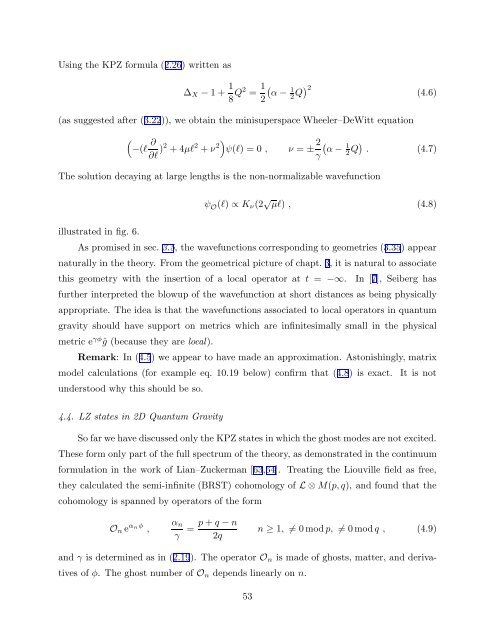arXiv:hep-th/9304011 v1 Apr 5 1993
arXiv:hep-th/9304011 v1 Apr 5 1993
arXiv:hep-th/9304011 v1 Apr 5 1993
Create successful ePaper yourself
Turn your PDF publications into a flip-book with our unique Google optimized e-Paper software.
Using <strong>th</strong>e KPZ formula (2.26) written as<br />
∆ X − 1 + 1 8 Q2 = 1 2(<br />
α −<br />
1<br />
2 Q) 2<br />
(4.6)<br />
(as suggested after (3.22)), we obtain <strong>th</strong>e minisuperspace Wheeler–DeWitt equation<br />
(<br />
−(l ∂ ∂l )2 + 4µl 2 + ν 2) ψ(l) = 0 ,<br />
ν = ± 2 γ<br />
(<br />
α −<br />
1<br />
2 Q) . (4.7)<br />
The solution decaying at large leng<strong>th</strong>s is <strong>th</strong>e non-normalizable wavefunction<br />
ψ O (l) ∝ K ν (2 √ µl) , (4.8)<br />
illustrated in fig. 6.<br />
As promised in sec. 3.5, <strong>th</strong>e wavefunctions corresponding to geometries (3.35) appear<br />
naturally in <strong>th</strong>e <strong>th</strong>eory. From <strong>th</strong>e geometrical picture of chapt. 3, it is natural to associate<br />
<strong>th</strong>is geometry wi<strong>th</strong> <strong>th</strong>e insertion of a local operator at t = −∞. In [7], Seiberg has<br />
fur<strong>th</strong>er interpreted <strong>th</strong>e blowup of <strong>th</strong>e wavefunction at short distances as being physically<br />
appropriate. The idea is <strong>th</strong>at <strong>th</strong>e wavefunctions associated to local operators in quantum<br />
gravity should have support on metrics which are infinitesimally small in <strong>th</strong>e physical<br />
metric e γφ ĝ (because <strong>th</strong>ey are local).<br />
Remark: In (4.5) we appear to have made an approximation. Astonishingly, matrix<br />
model calculations (for example eq. 10.19 below) confirm <strong>th</strong>at (4.8) is exact. It is not<br />
understood why <strong>th</strong>is should be so.<br />
4.4. LZ states in 2D Quantum Gravity<br />
So far we have discussed only <strong>th</strong>e KPZ states in which <strong>th</strong>e ghost modes are not excited.<br />
These form only part of <strong>th</strong>e full spectrum of <strong>th</strong>e <strong>th</strong>eory, as demonstrated in <strong>th</strong>e continuum<br />
formulation in <strong>th</strong>e work of Lian–Zuckerman [63,64]. Treating <strong>th</strong>e Liouville field as free,<br />
<strong>th</strong>ey calculated <strong>th</strong>e semi-infinite (BRST) cohomology of L ⊗ M(p, q), and found <strong>th</strong>at <strong>th</strong>e<br />
cohomology is spanned by operators of <strong>th</strong>e form<br />
O n e α nφ ,<br />
α n<br />
γ = p + q − n<br />
2q<br />
n ≥ 1, ≠ 0 mod p, ≠ 0 mod q , (4.9)<br />
and γ is determined as in (2.19). The operator O n is made of ghosts, matter, and derivatives<br />
of φ. The ghost number of O n depends linearly on n.<br />
53
















